Just a few years ago, some of the great bargains on the vintage amp market were the Valco-made Supro amps of the 50’s and 60’s. While their price has gone up for many reasons (the most justifiable one being a lot of them are GREAT sounding amps), the primary reason seems to be the Jimmy Page factor. Over the last couple of years, I’ve started casually tracking how many different models of Supro amps people CLAIM was the amp that Jimmy Page used on the first two Led Zeppelin albums. It’s a non-scientific and highly anecdotal study, to be sure, but so far I have counted NINE different models of amps that people claim (with the certainty that only stupidity mixed with arrogance can achieve) are THE MODEL that Page used.
It doesn’t really matter, of course. No one sounds quite like Jimmy Page (least of all Jimmy Page these days) and how an amp sounds on an album isn’t exactly how it sounds in a club, anyway. The difference between six inches of mic placement in a studio can make a great amp sound like crap and vice-versa. Yet, people pay through the nose for amps because they think they’ll sound like Jimmy Page if they buy them. Whatever.
But what’s missed in all this (sadly) is that there’s a reason Page dug the Supros in the first place. They sound great. Whether it’s the Thunderbolt, or the Corsica, or the Dual Tone (all claimed by various “experts” as THE AMP Page used), they, and many other models, are great sounding amps.
They are also, at this point, getting to be very expensive amps. And there’s nothing wrong with paying a grand for a Thunderbolt if you want one. They sound awesome for guitar, they’re loud enough for clubs, and they aren’t too heavy to carry. They are point to point (true point to point – not hand loaded circuit board like vintage Fenders. Not that either is better, but Fenders aren’t, technically, point to point). They’re well made, with good parts and, in general, tougher cabinets than other budget tone monsters like Danelectros.
But, some things have gone plain loco in the vintage market. Example A? People are paying over $4,000 for the Supro Dual Tone (AKA the 1624T). And while this is a killer amp, that’s just insane (unless I’m selling it, in which case, it’s worth every penny). Why are the prices so high for this model? You guessed it – it’s the latest that has been swept up by the “as played by Jimmy Page” tidal wave.
But let’s say you’re interested in tone. Not who played what. You want to sound like you, and you want a really cool amp to do it with, and you don’t have an extra 4 Large kicking around your wallet. What’s a tone freak to do?
Well, if you like the sound of that Supro (and it IS a sound worth having, no matter who owned, played, looked at or smelled the damn thing), try and find a circuit that’s similar and go from there. What gave that model Supro its unique and cool tone? Well, as they say, everything affects everything, but the main contributors to that tone machine are the pretty basic 12AX7’s in the preamp and the cathode-biased oddball output 6973 tubes. These have an overdrive all their own – not quite a 6V6; not quite an EL84. They definitely have their own thing going. Chime and midrange grit at the same time – and they’re largely responsible, I’d guess, for when people call these model Supros slightly Vox-like in their overdriven mode.
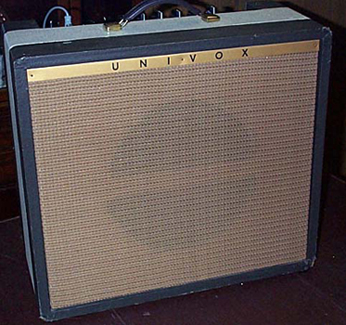
Univox 202R Guitar Amplifier
What’s an affordable, well made, very cool and not ridiculously expensive amp that’s like the 1624T? I’d say you might want to look at the Univox 202R. The early version of this amp is true point-to-point (before 66 or so, it seems – there’s not a lot of information on Univox amps). Later versions are printed circuit board, like the great little Univox U45 amps (they are mini tone MONSTERS). But the circuit and cap and resistor values stayed pretty much the same. If you can, it’s always better to find the point to point ones, as they’re easier to work on and tougher built – but the PCB ones are good amps, too. Univox amps were made in Japan (all the ones I’ve seen) – most of the ones I’ve been under the hood of were made at the Guyatone factory, and then imported to the United States and branded with various names (see below for some of the other names for this amp).
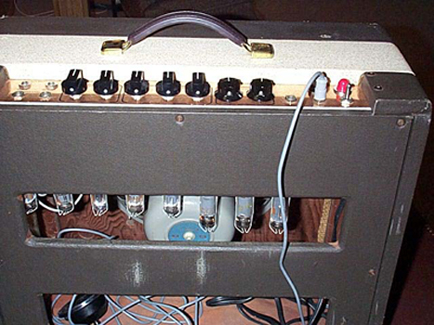
Univox 202R Guitar Amplifier
These are single 12″ combo amps with Reverb and Tremolo (both VERY nice – a good throbbing smooth trem and a cavernous verb). Chanel one has a Volume and Tone knob, plus the ‘verb and trem. Channel two has only volume and tone, but you can patch the two together for a fuller, raunchier sound. “Normal” and “Bright” inputs for each channel. Earlier models have the following tube lineup: 12AX7 (3), 6AN8, 6AV6, 6973 (2) and a 6CA4 rectifier.
I’ve seen them with ceramic Jensens that seemed original. Mine, a very early model, has a “Deerfield” ALNICO, (looks to be original) with no other markings or speaker codes (your guess is as good as mine – anyone know about “Deerfield”? Drop me a line). Most examples of the 202R have a gold control panel with big round black knobs that look like old Magnatone knobs. They are frequently two-tones, with a dark covering, then a white stripe in the middle, topped off by a handsome wheat-colored grille cloth. They’re lookers.
How does it sound? Pretty incredible. At low volumes it has a slightly dark, incredibly warm clean sound. Think of Peter Green’s tone on “Albatross.” Clean, but wooly. It can get bright, but you’ll need a Tele or a similarly bright guitar to coax that out of it. It’s got that classic mid-60’s budget American midrange-y tone to it that’s to die for.
Turned up and it really starts to release some beautiful overtones from the 6973s. These are a relatively strange output tube for a guitar amp. They were used mostly in old Wurlitzer Jukeboxes, but they make guitar amp appearances in some Supros, the awesome Magnatone 280s and 480s and a few Univox models. As stated above, they have their own thing going, and it’s a good thing at that. A very warm, yet raunchy and still creamy overdrive that cuts well through/with a band. Also, while 6973s were VERY hard to find for a while, and NOS examples were obscenely priced, Electro Harmonics is making a new version that sounds great and costs under 35 bucks a pair. The new EH tube is a lot like their highly respected 6V6 – nice and rugged with a very robust tone. So you won’t have to shell out ridiculous money to re-tube your new tone beast.
These are still available for under $400 with regularity. It will probably go up, as people find out more about the obscure brands (or, err, the MORE obscure brands) in their search for great 60’s tone on the cheap. But, even for a fair amount more than $400, these are great amps. For low volume work, they have a very impressive clean, and turned up they sound like garage heaven. Get yours now before Jack White or somebody discovers them. Or before I start a website saying Jimmy Page used it on EVERYTHING he EVER recorded!
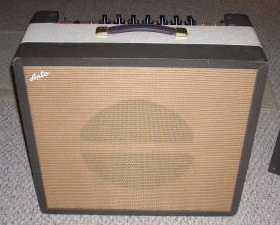
Univox 202R Guitar Amplifier (with Apto badge)
A final note about Univoxes and their various rebrands. The same amp could (and will, on eBay) frequently wear several names. There is, of course, Univox. BUT, you could find the same amp with a “Lafayette” badge. Mine has an “Apto” badge (imported to New York by the “Apto” Accordion Company). I’ve seen one that looked just like these with a Magnavox badge. So, familiarize yourself with the basic look of this model and ask questions about the tube lineup, and you may find yourself with a very cool Univox 202R. No matter what the name on the faceplate, the tone is something special. Happy hunting.
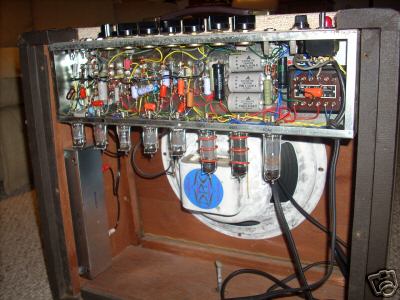
Univox 202R Guitar Amplifier (with Apto badge)
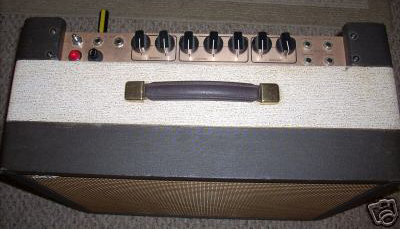
Univox 202R Guitar Amplifier (with Apto badge)

such a gorgeous univox! i just picked up a chassis for this amp and was wondering if you might be able to send me a little help in getting a new cab built – dimensions etc…maybe a couple hi-res pics of the wiring? all your help is really appreciated…i’m stoked for this piece…
I own a Univox U-42 badged as Marathon and it has the only other DRC alnico speaker like yours that I have seen. Research provided no insight whatsoever about this speaker. I originally thought it was a cheap aftermarket replacement, with the agressive, modern lettering but I guess it’s more like circa 1960-1962…?
Just picked up a Lafayette off of craigslist the other day. Looks a lot like a 202R. Needs some work, but looking forward to digging into it. Good post here, thanks for sharing!
I bought anp very much like this but with fewer 12AX7 tubes. Info on these old amps is hard to find. My amp has only 6 knobs: From the front, the 2 btns on the rt are Chan 1 volume and tome, 2 on the left are chan 2 vol and tone. The 2 in the center are tremelo-speed and intensity. on the left is a single jack for ftsw. Inputs on the right are chan 1 inputs bright and normal, and chan 2 stereo and normal.
Any one know which one I might have?
I just picked up a Univox 202R that looks to be 100% except for an added grounded AC cord. The speaker is a 12″ 8 ohm Deerfield Alnico Speaker. Stamped on the underside of the magnet in red ink is 1056 244. I believe the number “1056” is the EIA manufacturers code for Gepco an OEM speaker company from Grayslake, Illinois, 15 miles from Deerfield, Illinois. The “244” would indicate the 44th week of 1962. I’m not really sure how these speakers ended up in these amps. There is a small sticker on the chassis of my amp that says MADE IN JAPAN!
Hope that helps…
oops…
meant to type GEFCO not GEPCO as the OEM speaker manufacturer.
Thanks
I am a semi pro musician. I play about 16 or 18 gigs a year in bars and sat. markets. My wife of 31 years died about three years ago from ALS. While caring for her the only thing I could do while caring for her was to trade guitar amplifiers. While in my care I traded everything from champs to super reverbs and everything thing else in between. Including mesa boogies, vox amps,and marshall heads and combos.
While on my quest I also traded electric guitars. On one occaision a guy I was buying a guitar from had a univox guitar amp that he was willing to part with. I bought it for $175.00 bucks not really knowing what I had. After bring it home I found it to have the best tube tone I’ve had ever heard and had already had a cap’ job done. It was fully operational so I started useing it with the band.
Soon after another univox amp came up on craigslist for $150.00. and I bought it right away. This one was a U202R much like my first one but was a bit louder before breakup and like the one in the pictures.I had my amp tech re cap it for about $200 bucks and have been using it ever since with my band. It’s hard to explain the tone when you bridge it and turn it up to about 3/4 but I have never heard anything sound better.
Someone always comes up in clubs where we are playing and asks me what the #@@$ are you using and take pictures with their phones. I have since gotten rid of all other amps and currently own and use a U202R, a U202, and a U-45B for practice and am in amp hog heaven. All for only a few hundred dollars. The U 45 B was $120.00 bucks and is plenty loud enough for practice. Eat your heart out guitar players you can barely find a picture of these great early 60’s Japanese guitar amps let alone buy one. Good luck in your search though and Forget the Jimi Page thing. Thunderbolts and Silvertones are cool but not as cool as a U202R by a long shot.Listen for your self.
I have been playing in a band for the last five years with these amps after Solderhaus recapped one for me, I own two. One is a little different and the tolex peeled off so I replaced the piping and gave it a clear coat. It looks really cool and the other a two tone job with reverb, (doesn’y work) and tremelo,That does work. 6973 power tubes are the very best sound I have found after playing countless amps. Do keep it our little secret please!
My Dad gave me the Univox 202R when I was 13, back 1978. I didn’t work for very long and I remember using a Little Muff fuzz box with it. Three years ago, it cost $300 to completely refurbish it! I don’t need any distortion assistance now…. just turn it up full! What a tone! The best amp I’ve had, better than my Marshall JCM 800.
Thank you for the great article and information! A friend of mine just gave me an amp and some extra GE tubes for it. The amp brand was “Matusek”. I posted pics on the Gear Page as to what this amp was. An astute answer was given that the amp was a re-branded Univox U 202. A search on the internet led me to this page. A search for Matusek yielded nothing, but turns out, Matusek was an Accordian company based in Chicago. This amp is pretty amazing! I too have the Deerfield speaker in mine. I just bought a vintage Jensen P12Q. Looking forward to dropping it in, and checking the amp out.
I have recently acquired a Univox amp that looks like your U202R but does not have reverb. It has 6AQ5 output tubes and 3 input jacks (Marked: Guitar Acc & Mic) and only 3 knobs (Volume, Tone, Tremolo) a footswitch jack, pilot light and a 3 position toggle switch for on, off and standby. Does anyone know anything about this model?
Thanks.
I just purchased a barn find Lafayette LA-100R amplifier made by Univox. 6973 output tubes, 3 12ax7s, 6CA4 rectifier tube, 6AV6, 7247. Two 12″ Jenson speakers. It is in the 1967 Lafayette catalog. Reverb and tremolo. 6 small tag boards with components on them. Chrome Univox chassis.